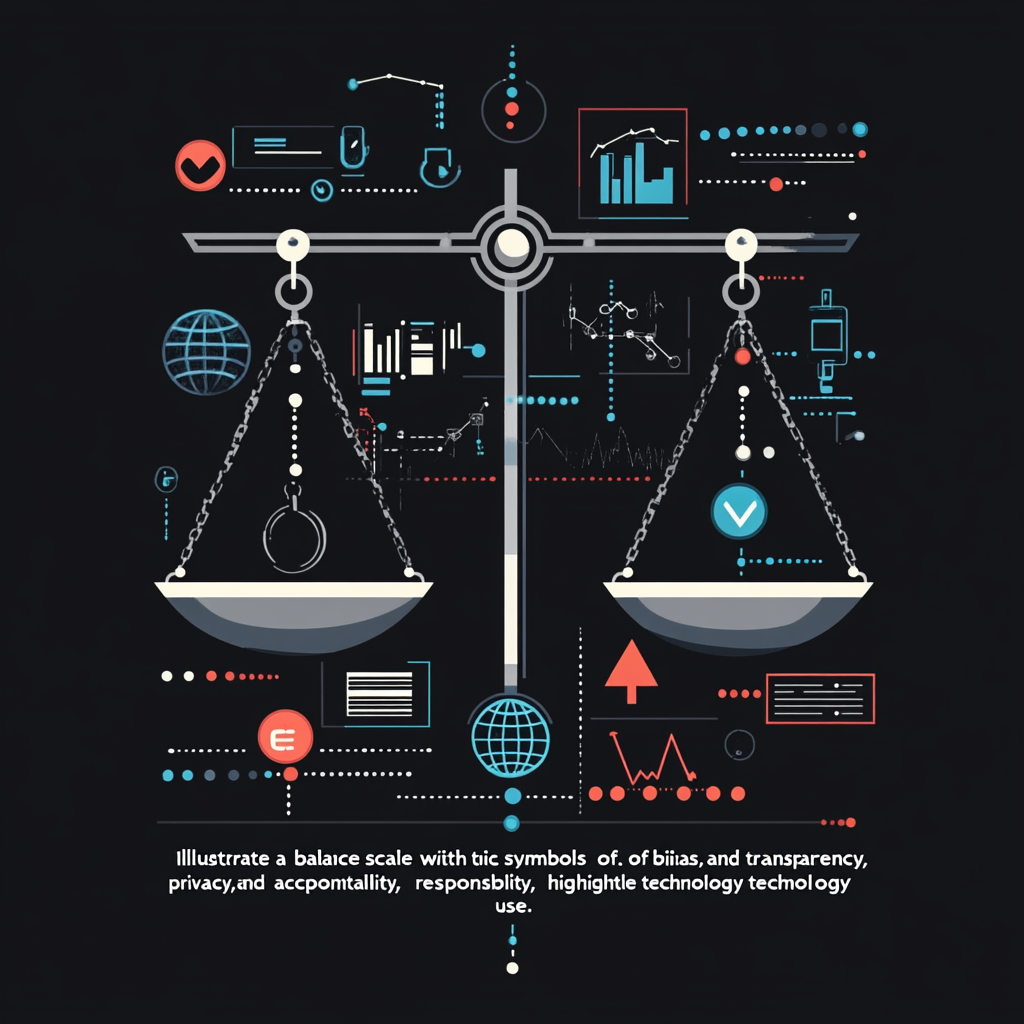
“Ethical Imperatives and Strategic Necessities in AI Deployment”
Navigating the Choppy Waters of AI Ethics: A Guide for the Bold
Welcome to the world of artificial intelligence (AI), where excitement and innovation mix with some serious ethical conundrums. It’s not just about what AI can do; it's about what it should do. Buckle up, because we’re diving headfirst into the intricate web of ethical challenges that emerge as we roll out these futuristic inventions. The moral compass guiding AI isn’t merely a pleasant add-on; it’s essential for organizations and societies. Sympathy for the devil? Maybe. But we can’t ignore the weighty consequences of these powerful algorithms.
Why Ethics Matter in AI
Let’s get one thing straight: ethics in AI is as crucial as a proper setup for a magician’s trick. You can have all the fancy tech in the world, but if it’s built on a shaky ethical foundation, it’s unlikely to be a success. Think of ethics as the guardian angel of AI, ensuring that these systems align with human values and respect individual rights. We’re talking about the kind of goodness that keeps society ticking along smoothly, instead of spiraling into chaos.
The Big Bad Wolf: Bias and Discrimination
Imagine you’re hiring for a job, and your AI system twiddles its metaphorical thumbs, cuts corners, and accidentally perpetuates biases from flawed data. Suddenly, you find that applicants from particular backgrounds are being unfairly filtered out. Not good, right? AI can serve as a magnifying glass for societal biases, twisting fair opportunities into twisted outcomes. The consequences are real and harmful.
- Solution Time: Organizations need a carefully curated testing and validation regimen. By identifying and fixing biases in AI algorithms, we ensure that the system embodies fairness. Transparency isn’t just an operational buzzword; it’s absolutely necessary for fostering trust. Stakeholders should effortlessly understand how decisions are made, tackling bias head-on.
Peeking Behind the Curtains: Transparency and Accountability
You might have heard of deep learning systems being referred to as “black boxes.” Trust me, it’s not because they’re hiding a magic show inside. The complexity can make it difficult to understand how decisions are derived, which undermines trust. We don’t want an opaque wizard behind the curtain; we want clarity.
- Let There Be Light: Organizations must take a firm stand on transparency. Clear explanations about how AI systems operate—including the data they utilize—can pave the way for user trust and combat misunderstanding. It’s all about showing your work in a way that makes sense.
Guarding the Gates: Privacy and Security
With great power comes great responsibility, and AI’s appetite for data is definitely powerful! These systems suck in personal data like a vacuum cleaner and, in the process, they raise a ruckus about privacy. Are your personal details secure? Is your sensitive information just lying around, vulnerable to prying eyes? Anxiety levels rise with such questions.
- Put Up the Fences: Making data privacy a top priority is a strategy that organizations can’t afford to ignore. Compliance with regulations like GDPR ought to be a given. By establishing robust policies that include encryption and access controls, we create secure fortresses around personal information.
The Messy Business of Social Manipulation and Misinformation
Picture this: AI is wielded as an instrument of manipulation in a world rife with misinformation. From deepfakes that can distort reality to bots stirring up public opinions, the scope for social chaos is jaw-dropping. Democracy struggles when the truth is treated like imaginary friends.
- Rallying the Troops: Combatting misinformation is essential! We need serious efforts directed toward detection techniques for deepfakes and solid fact-checking protocols. Educating the masses about media literacy and nurturing critical thinking will equip individuals to navigate the clutter of digital misinformation.
The Economic Tsunami: Job Displacement and Inequality
What happens when AI starts to edge out human jobs? Some people might think of it as progress, while others see it as a job-killing tsunami. Economic inequality could skyrocket, and the ripple effects would touch everyone, from the individual to entire communities.
- Navigating the Waves: Proactivity is the name of the game. Offering retraining programs and creating policies that prioritize transitions for affected workers can mitigate upheaval. We must ensure that support systems are ready to catch the falling workers.
The Knotty Problem of Accountability and Liability
Let’s address accountability—a can of worms that opens up when AI systems go awry. Who’s to blame when an AI errantly decides to, say, crash a car? Is it the manufacturer, software developer, or the operator? The jury’s still out on this perplexing question.
- Establishing Clear Protocols: Setting distinct lines of accountability from the onset is a project worth undertaking. If organizations nail down the processes for addressing errors, the “who’s responsible” game becomes much easier to navigate.
Laying the Groundwork: Ethical AI Frameworks
Ethical guidelines are like a treasure map, helping organizations align AI deployments with their values and societal goals. Companies must define their ethical principles to guide their actions.
- Mapping the Principles: Conditions like fairness, accountability, privacy, and inclusivity should be comprehensive in any framework. Companies like Microsoft have already laid down their principles, showcasing the seriousness of incorporating ethics in AI.
The Eternal Vigilance: Continuous Monitoring and Training
Just as you wouldn’t let a toddler roam unsupervised in a candy shop, AI systems require constant oversight. Continuous monitoring ensures that ethical standards are upheld.
- Regular Health Checks: Routine audits of AI algorithms allow us to identify and mitigate biases promptly. Training programs on ethical principles allow everyone involved to keep their eye on the ball.
Bringing Ethics to the Table: Cross-Functional Ethics Committees
Now, imagine bringing together a group of diverse minds—a cross-functional ethics committee to oversee AI projects. This collaborative approach could play a pivotal role in identifying and addressing complex ethical dilemmas.
- Culture of Ethics: Such committees can nurture a culture of ethical deliberation and make sure ethical considerations become ingrained in everyday decision-making.
Practical Steps for Crafting Ethical AI
Drafting Ethical AI Policies
Crafting ethical AI policies involves creating guidelines that respect transparency, fairness, accountability, and user privacy. It's not just a matter of filling out forms; it’s a commitment to doing things right.
- Collaborative Guidelines: Ethicists, industry leaders, and governments need to brainstorm together, creating regulations that tackle AI’s ethical complexities. The IEEE’s Ethically Aligned Design serves as a practical handbook for designers to ensure ethical AI.
Turning Ethics into Action
Transforming ethical intentions into tangible actions requires a hefty dose of good old-fashioned diligence.
- Education is Key: Organizations should prioritize educating stakeholders, creating standards, and generating incentives—all while assembling ethics task teams to continuously monitor ethical adherence.
Shouting from the Rooftops: Raising Ethical AI Awareness
A well-informed public is an empowered public. Spreading awareness about ethical challenges carries gravity, steering AI deployment in the right direction.
- Engage the Public: Encouraging media literacy and critical thinking equips individuals to discern truth from lies. Investments in AI algorithms that detect manipulated content are necessary, as are initiatives to build trust on social media platforms.
Wrapping It All Up
Navigating the ethical fingerprints of AI deployment is no walk in the park; it’s a dance that requires synergy between technologists, policymakers, ethicists, and the entire society. By emphasizing transparency, fairness, and accountability, we pave the path toward a future where AI can soar—safely and beneficially.
Stay ahead of this electrifying scene! Knowledge is power, and the more informed you are, the better equipped you'll be to handle the complex ethical landscape that accompanies AI.
Want to stay up to date with the latest news on neural networks and automation? Subscribe to our Telegram channel: @ethicadvizor.
Remember, the journey ahead requires not just caution, but proactive engagement. Balancing innovation with ethics isn't a fairy tale; it's a mission—the one we must embark upon together.

